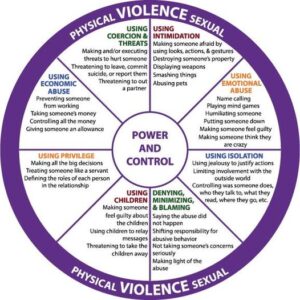BRIDGES is focusing on domestic violence in October.
What is domestic violence?
It’s a pattern of behavior used by one person in an intimate relationship to gain and maintain power and control over their partner. Domestic violence includes current and former spouses and dating partners and can be physical, sexual, emotional, economic, or psychological actions or threats of actions that influence another person. This includes any behaviors that intimidate, manipulate, humiliate, isolate, frighten, terrorize, coerce, threaten, blame, hurt, injure, or wound someone. Domestic violence can vary in frequency and severity and occurs on a continuum, ranging from one episode that might or might not have lasting impact, to chronic and severe episodes over a period of years.
Data
Information from CDC’s National Intimate Partner and Sexual Violence Survey (NISVS) shows:
- About 1 in 4 women and nearly 1 in 10 men have experienced contact sexual violence, physical violence, and/or stalking by an intimate partner during their lifetime and reported some form of IPV-related impact.
- Over 43 million women and 38 million men experienced psychological aggression by an intimate partner in their lifetime.
Power wheel
Physical and sexual assaults, or threats to commit them, are the most apparent forms of domestic violence and are usually the actions that allow others to become aware of the problem. However, regular use of other abusive behaviors by the batterer, when reinforced by one or more acts of physical violence, make up a larger system of abuse.
Although physical assaults may occur only once or occasionally, they instill threat of future violent attacks and allow the abuser to take control of the woman’s life and circumstances. The Power & Control diagram is a particularly helpful tool in understanding the overall pattern of abusive and violent behaviors, which are used by a batterer to establish and maintain control over his partner. Very often, one or more violent incidents are accompanied by an array of these other types of abuse. They are less easily identified, yet firmly establish a pattern of intimidation and control in the relationship.

What is the “Equality Wheel”?
The Equality wheel is a model used to explain the dynamics of a healthy relationship. It is applicable to all forms of relationships; with friends, dating partners, intimate partners, life partners, or family members. Each component of the wheel supports and reinforces the others, with equality always at the center. The Equality wheel can be used by anyone as a guide to maintaining healthy patterns in a relationship.
The Center of the Wheel:
Equality: Equality is the foundation of any healthy relationship
The Spokes of the Wheel:
Trust: trust appropriately. You would trust your life partner more than you would trust a new acquaintance.
Support: Support each other. Encourage others in their goals, activities, and personal growth.
Respect: Respect other people’s boundaries. Learn other people’s boundaries and do not infringe upon them.
Responsibility: share responsibility for maintaining a relationship. Both people in a relationship should be included in making decisions.
Communication: communicate effectively. Effective communication involves clearly expressing your thoughts and feelings and listening to those and others.
Boundaries: maintain healthy boundaries. Create safe and comfortable space to experience relationships by defining and communicating your boundaries to others.
Honesty: Be open and honest. it is important for both people in a relationship to be honest about their intentions, feelings, or desires.
Accountability: Be responsible for your own actions. Talk to others to understand how your actions affect them.
The Outer Circle of the Wheel:
Non- Violence: there is no place for violent acts or behaviors in a healthy relationship. Examples of violent acts or behaviors include yelling, name-calling, minimizing feelings, throwing things, unwanted touching, pushing, hitting, stalking, and forced sex.


